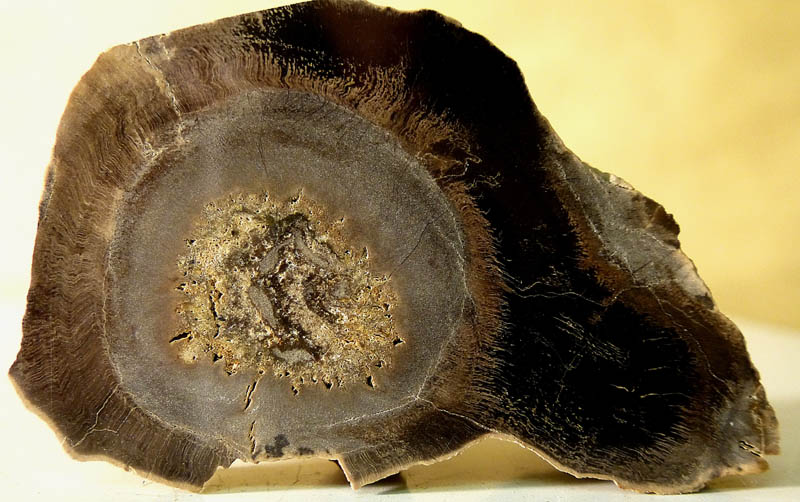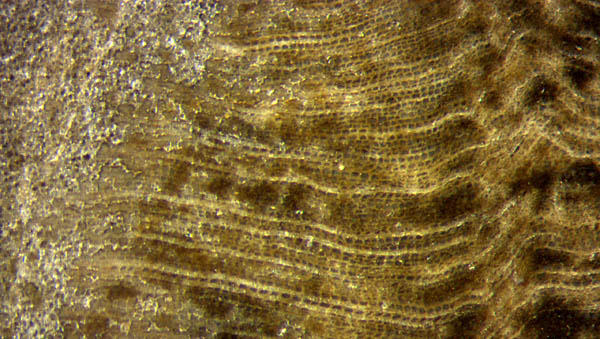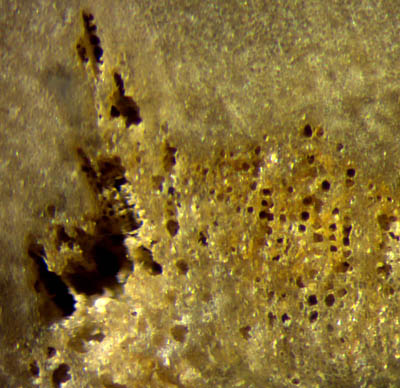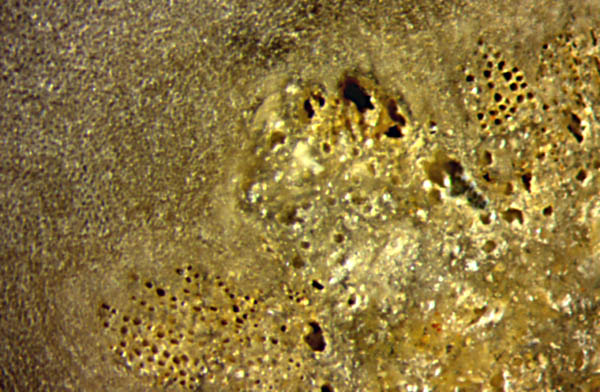Permian wood with uncommon
details
As a well-known fact, silicified wood often shows details which do not
really represent the wood
structure but are due to secondary phenomena like fungus activity or
degradation. Often one cannot tell which process had caused a
particular feature. 
The nearly circular area mainly
consisting of a gray ring surrounded
by coniferous-type wood (Fig.1) could be mistaken for a centre with
pith but is no such. Closer inspection reveals that it is also
coniferous-type wood but in a degraded state with the originally radial
files of cells largely dissolved. This ring-shaped part of the polished
face is not thoroughly silicified, judging from the lack of gloss and
from the ability of soaking up water. What seems to be a definite
boundary between degraded and well-preserved wood is a rather fuzzy
transition zone in some places, indicating continuity of the wood
before partial degradation had caused the contrast.
Fig.1: Small stem cross-section with degraded (gray) and well preserved
coniferous-type wood. Width 50mm.
Fig.2: Degraded and well
preserved wood, detail of Fig.1. Width 2.8mm.

Most of the wood had been broken off along shrinkage cracks
formed after silicification, except for the segment below
right.
Fig.1
might suggest the simple idea that a concentric area of this stem had
been prone
to decay but reality is not as simple as that: Farther out on the
right,
beyond the well preserved black wood, there is another area of gray
degraded wood, without any symmetry.
More
unexpected details are found inside the gray concentric ring.
Its
inner boundary appears extremely rugged, with irregular-shaped
cavities preferably pointing into radial direction (upwards
in Fig.3). 

Fig.3: Rugged boundary between stem centre and
decayed coniferous-type wood above, with pockets of well-preserved wood
in between.
Width 4.3mm.
Fig.4: Detail of Fig.3.
Wood cells 37...60µm in files.
Width 1.4mm.
Fig.5 (below): Same as Fig.3. Additional pocket, not similar to wood or
pith.
Width 2.8mm.
 Usually
most of the central pith of coniferous-type stems had decayed before
silicification. Persisting pith, if there is any, may be found most
likely near the boundary between centre and wood, as seen in Fossil
Wood News 27.
Surprisingly, the clearly seen cells set apart from the degraded and
shrunken wood in
Figs.3-5 are not the expected pith but miraculously preserved pockets
of wood, with non-deformed cells in straight files. Degraded
and shrunken cells and files are faintly seen
in some places on the left in Fig.5.
Usually
most of the central pith of coniferous-type stems had decayed before
silicification. Persisting pith, if there is any, may be found most
likely near the boundary between centre and wood, as seen in Fossil
Wood News 27.
Surprisingly, the clearly seen cells set apart from the degraded and
shrunken wood in
Figs.3-5 are not the expected pith but miraculously preserved pockets
of wood, with non-deformed cells in straight files. Degraded
and shrunken cells and files are faintly seen
in some places on the left in Fig.5.
Conspicuous in Fig.5 is an enigmatic
pocket clearly separated from both the preserved and the degraded wood.
There is no indication in which way it could have formed. Apparently
this type of formation tends to make the cavities seen in Figs.1,3,4,6.

Fig.6 (left):
Peculiar inclusions inside stem centre, rugged boundary, and
degraded wood above.
Width 8mm.
A faint texture of the slightly squeezed degraded wood is also seen in
Fig.6. Most peculiar are the distinct gray inclusions among the odd
stuff
filling the centre. There are several of them (see also Fig.1), with
degraded cellular
structure, cell sizes about 40µm. Wood with inclusions of this kind
seems to be rare. A sample with similar aspect is known from
Kilianstädten [1].
Sample: found in the early 90s on
the golf course at
Wilmsdorf, Doehlen Basin
near Dresden, stored in the own collection under W/35.1.
H.-J.
Weiss 2019
[1] R. Noll, V.
Wilde: Petrified
Wood from Central Germany.
in: U. Dernbach, W.D.
Tidwell: Secrets of
Petrified Plants, D'ORO 2002, p.95.
|

|
 33 33 |

 33
33



 Usually
most of the central pith of coniferous-type stems had decayed before
silicification. Persisting pith, if there is any, may be found most
likely near the boundary between centre and wood, as seen in Fossil
Wood News 27.
Surprisingly, the clearly seen cells set apart from the degraded and
shrunken wood in
Figs.3-5 are not the expected pith but miraculously preserved pockets
of wood, with non-deformed cells in straight files. Degraded
and shrunken cells and files are faintly seen
in some places on the left in Fig.5.
Usually
most of the central pith of coniferous-type stems had decayed before
silicification. Persisting pith, if there is any, may be found most
likely near the boundary between centre and wood, as seen in Fossil
Wood News 27.
Surprisingly, the clearly seen cells set apart from the degraded and
shrunken wood in
Figs.3-5 are not the expected pith but miraculously preserved pockets
of wood, with non-deformed cells in straight files. Degraded
and shrunken cells and files are faintly seen
in some places on the left in Fig.5. 

 33
33